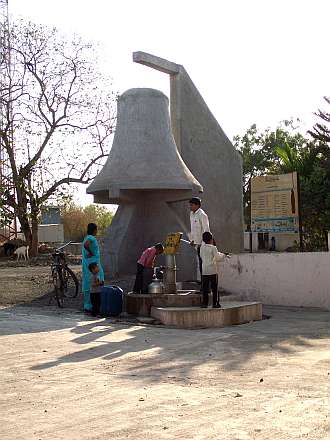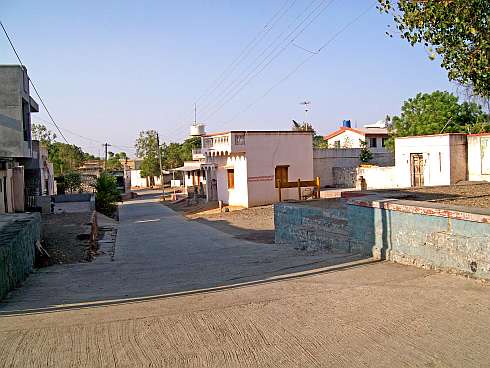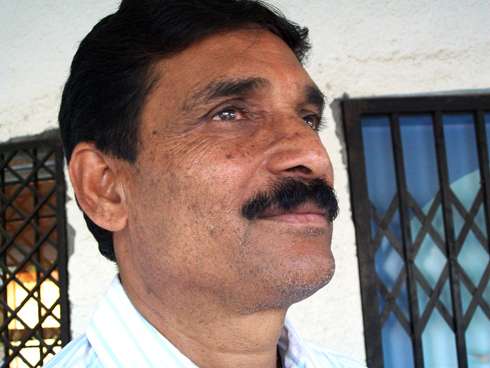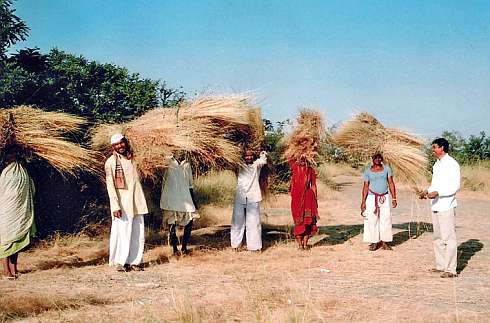Raosaheb Pawar, 85, a former wrestler, cycles to the village square at Hiware Bazar in Ahmednagar district of Maharashtra to sit under shady trees and chat with others, most of them as old as him. Life is good for all of them as they have become prosperous, and often the conversation is about their village that was such an unlivable place 25 years ago. Raosaheb thought that most of the villagers would die of poverty and hunger. Today, a deep sense of joy and gratitude swells within him as he talks about how just one young sarpanch came into their lives and transformed their future. He proudly says he owns 45 acres of lush fertile land, one tractor, one harvesting machine and three motorcycles. His annual turnover: Over Rs. 15 lakh. He is not the only one. There are 60 millionaires in the village today who are all farmers!

![]()
Clean drinking water from a tubewell at Hiware Bazar Pic: Ramesh Menon.
Just a little over two decades ago, Hiware Bazar was a village without hope. It was racked with droughts, year after year. There was no water in the wells. The land was seriously degraded as the trees had been cut and used as firewood or sold. There were no job opportunities. There were numerous illicit liquor dens and alcoholism was tearing into the social fabric. Domestic violence was naturally rampant.
Remembers Raosaheb: “We lived in a very ordinary poor village, but were happy with our simple lives. But after 1972, when a severe drought struck, the peace was shattered. People became irritable and restless as the struggle to stay alive became severe. Petty reasons were enough to trigger off bitter quarrels as there was so much despair and frustration. Villagers started consuming liquor and it added to our ruin. Many of us left our empty fields and migrated to nearby cities to work as daily wage labourers.”
Poor Governance
There was no governance worth the name. The village was sliding towards disaster. As India started to ramp up economic growth, new opportunities began to sprout and young Indians started dreaming of a resurgent India. The youth in Hiware Bazar wondered why they too could not be a part of that dream. What the village needed was a visionary leader. Thus, they got together in 1989 and persuaded Popatrao Pawar, the only post-graduate in the village, to contest for sarpanch.
Popatrao was just in his mid-twenties and his family wanted him to take up a white-collar job as they saw no hope of him doing well if he stayed on in the village. As it was, 90 per cent of villagers had already migrated. Hiware Bazar was no place to live in. Despondency, hopelessness and unaddressed anger punctuated their lives.
As soon as he took over, he got the liquor dens closed down and banned the consumption of liquor, tobacco, paan and gutka. There was scarcely any opposition as the whole village knew what addiction had done to them and their dear ones. Says Laxman Pawar, a farmer: “When the liquor dens were closed, we saw hope for the first time.”
Water management
The next step was to ensure that every rain drop that fell in the village stayed within and did not flow away. Numerous check dams were built by the villagers as Popatrao told them that they should be pro-active, not wait for the government to do everything. Trees were planted before the rains every year. Ponds were dug up to store rain water that gradually enriched the water table. Soon, they had created 52 earthen bunds, two percolation tanks, 32 stone bunds, and nine check dams.
“We used just allocated state government funds. The shramdan cut costs and also ensured quality work. It was as if we were building it for ourselves and for our children. Participatory governance goes a long way,” says Popatrao.
Being in the rain shadow region, Hiware Bazar got just about 15 inches of annual rain. Soon ponds and trenches stopped rainwater from flowing out of the village. After the very first monsoon, the irrigation area increased from 20 hectares to 70. “ In 2010, the village got 190 mm of rain, but we managed well because of water management,” says Habib Sayyed, who works closely with Popatrao on monitoring the water situation.
Watershed management has also helped them harvest multiple crops. Before 1995, there were 90 open wells with water at 80-125 feet. Today, there are 294 open wells with water at 15-40 feet. Villages in Ahmednagar district drill nearly 200 feet to hit water.

Hiware Bazar village. Pic: Ramesh Menon.
In the course of a few years, with the water level in the wells rising, farming became a full time activity. It immediately created conditions for prosperity to bloom. In 1995, 168 of its 182 families were below the poverty line. Today, government estimates put it at only three. But Popatrao says that by Hiware Bazar’s definition, there are 12 BPL families. The village considers a family under BPL if it cannot have two full meals a day, cannot pay for children’s education and cannot afford health-care services. “Give us another one year to make Hiware Bazar a BPL-free village. No one here will be poor,” says Popatrao, as the village administration is already working on a strategy to draw them out of poverty.
In 1995, only one-tenth of land in Hiware Bazar was arable. Out of a total of 976 hectares, 150 hectares was rocky. Nature was against them as there were recurrent droughts. Now, even that stubborn land is being tamed with the rocks being removed and the land ploughed so that sowing can start when the rains come.
Anshabapu Thange had two acres lying fallow 15 years ago. But once water was available, he went back to farming. Today, he has 25 acres growing maize, flowers and fodder. He also has 30 buffaloes yielding 250 litres of milk a day. “Earlier, we did not have grain to eat. It is water that helped us become rich,” he says.
Such success stories abound in this village that has 235 families and a population of about 1,250. In 1995, the monthly per capita income was around Rs. 830. Now, it has crossed Rs. 30,000.
Healthy Practices
Hiware Bazar looks different. What really stands out is that it is squeaky clean. There is not a single piece of garbage on the roads. How many sweepers has the village panchayat employed? None. Popatrao told the villagers that each of them has to keep the village clean as they owned it and it was not for sweepers to do the job.

Popatrao Pawar. Pic: Ramesh Menon.
The cement houses along well-planned clean roads are pinkish brown. There is a sense of discipline and order. And that strict order applies to open defecation and urination. Every house has a toilet, a fact that few Indian villages can boast of. Many houses use bio-gas, doing away with polluting fuel. The fields are lush with maize, jowar, bajra, onions and potatoes. Sugarcane and banana cultivation are not encouraged as these crops demand lot of water. Hiware Bazar is an oasis in a drought-racked area.
No wonder, the village sees reverse migration today. Villagers who had left to become daily wage labourers are now returning to life in this village that has its rewards. Once it became sustainable, there was prosperity. Farming was no more a bad word. 93 families have returned since 1997. More importantly, aspirations have increased with a better and peaceful lifestyle back home.
School students from the primary level go through a compulsory course on water literacy. To ensure that water is not over-used, water budgets are designed; cropping patterns are prescribed only upon estimation of water use and measurement of water levels. Monthly readings are taken to calculate the amount of water available. In 2007, the village won the National Water Award for community-led water conservation. The water audits determine which crops can be grown in a season, says Shivaji Thange who works closely with the watershed committee.
In the mid-nineties, a five-year plan was drawn up for ecological regeneration, integrating available government schemes. Around 10 lakh trees were planted increasing the forest cover and raising the water table. The temperature also fell by two per cent with the greenery. Babool trees used to be cut for fuel, but now, they are being protected as villagers harvest gum from it that is priced at Rs. 2,000 a kilo. The forest department is assisting villagers, making it a new commercial proposition.
Participatory Governance
As villagers were pulled in to make decisions and then implement them, there was no opposition as they got the feeling of ownership. The village was not divided by narrow politics. “We monitored everything we did so that funds were utilised properly. We had audits of all the work we did,” says Popatrao.
There is a different gender sensitivity, too, that one sees here. The gram panchayat has now decided that the second daughter’s education and marriage expenses will be taken care of by the village. In the seven-member panchayat, three are women. Sunita Shankar Pawar, is the sarpanch this year but Popatrao as deputy sarpanch is the cynosure of all eyes.
To improve farming and livestock production, the villagers took bank loans. Last year, the disbursement touched Rs.38 lakh. Late P.C. Alexander who was Maharashtra’s governor, found it remarkable that Hiware Bazar villagers repaid 100 percent of their loans, while the rich in India had defaulted with over Rs. 65,000 crore in unpaid loans!

Popatrao talking to villagers.
Introducing Simple Ideas
As farming increased, so did work. Getting labour was expensive, so Popatrao introduced the idea of collective farming. When a farmer is sowing, others join in to help so that he saves on labour. This practice has caught on and has created a new sense of belonging among all of them. Popatrao says that it is not money that can bring about rural change, but people working together to reach common goals without caste, creed and politics playing spoilsport.
Popatrao turned to concentrate on another activity that had the potential of bringing villagers additional revenue. He got them to stop cattle from grazing in the forest as it had ecological implications. Instead, he persuaded them to grow more fodder as there was water. The focus on livestock resulted in the gradual increase in milk production bringing in steady revenue. In the mid-1990’s, milk production was just about 150 litres a day. It has touched over 4,000 litres a day today.
The sarpanch did not rest on his initial laurels. He got the school working which was almost non-functional. Once again, children started going to school. He started a children’s parliament which monitored if teachers were regularly attending the school and if the students had any complaints. As students completed school, the desire to study further now takes them to a nearby college. In fact, thirty-two students from the village are now studying medicine.
There is no doctor in the village. “There is no need of a doctor here as everyone is healthy. No one can fall sick when the streets and houses are clean. We do not have open sewage systems, garbage lying around or open defecation which spreads disease,” says Popatrao proudly.
He motivated villagers to adopt family planning, take care of their health and hygiene, and even advocated that couples take a HIV test before marriage. Popatrao had a different outlook and villagers did not object as he always explained his ideas at meetings before taking any decision. Collective decisions have helped keep rancour away. The village has just one Muslim family and as there was no mosque for them to offer prayers, one was built for them. Banabhai Sayed and his family take part in all Hindu festivals and effortlessly sing Hindu bhajans.
Thinking Ahead
The village has always thought ahead. In 2008, the gram sabha passed a resolution requesting the avoidance of using cars within the village to save fuel; cycles could be used instead. If villagers want to go to Ahmednagar about 17 km away, they resort to a car pool. Most farmers opt for motorcycles.
Popatrao has now been made chairman of Maharashtra’s Model Village Programme that aims to create 100 villages like Hiware Bazar. He says he succeeded because of the participatory approach adopted and embraced by people who decided what they wanted and brought in need-based feasible plans. “I took 21 years to transform my village. Now, I have zipped the strategy to take just two years. With community participatory approach, we can create a new era of rural change.”
While tangible changes are visible, it is intangible lessons like change of consciousness, redefining political goals, willingness to sacrifice personal interests for the common good and cohesiveness in decision making that make Hiware Bazar a lesson for rural India. The Economics of Ecosystems and Biodiversity, a UN report, points out how looking after nature makes both economic and ecological sense. In India, Hiware Bazar has shown how it actually works.

